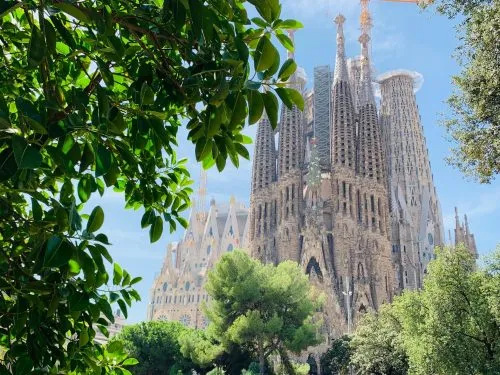 A Complete Guide for Visiting the Sagrada Família in Barcelona
A Complete Guide for Visiting the Sagrada Família in Barcelona
One of the most visited places in Barcelona is the ornate Roman Catholic basilica la Sagrada Família aka the Basilica of the Holy…
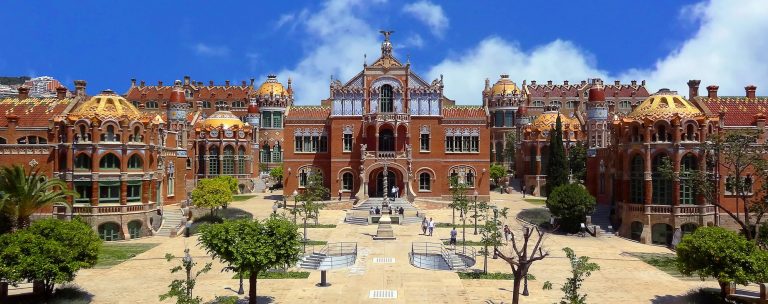
Join the ExperienceFirst Club for 10% off your purchase
By proceeding, you agree to our terms of use and privacy policy.
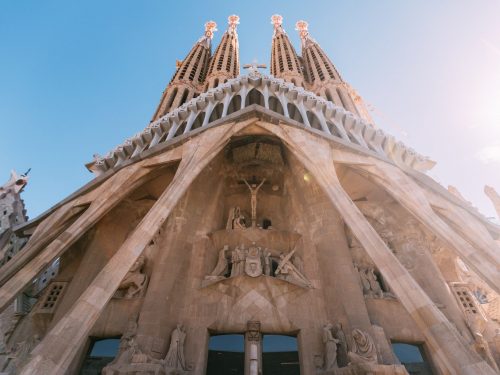
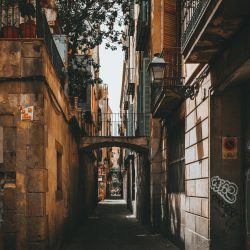

What are the must-see landmarks in Barcelona?
Barcelona is filled with amazing sights for travelers to explore. Many of the city’s biggest landmarks feature the unique modernist architecture Barcelona is famous for. If you want to visit these must-see modernist buildings, here’s a checklist:
Of course, you won’t want to miss Barcelona’s other museums and experiences that immerse you into Catalan traditions and culture. Here are a few of the best:
What are the best attractions in Barcelona for families?
From parks to museums, Barcelona has plenty of attractions the whole family will love. Ciutadella Park — the main park of Barcelona — is a great place to spend an hour or more on a sunny afternoon. Kids will love the open space to run around in, and adults will love the architectural landmarks like the Arc de Triomf. Here’s what else you can see and do in Parc de la Ciutadella:
With its many gardens, a magical fountain, and a 17th-century castle, Montjuïc also offers a variety of family-friendly activities. And Park Güell is a great place to get kids interested in Barcelona’s architecture — it looks like an architectural playground.
If you want to spend some time indoors, Barcelona’s museums are a great option for learning about the city’s history. Kids are sure to love the wax museum, but there are also plenty of family-friendly exhibitions at the National Museum of Art of Catalonia in Montjuïc and even the Museu Picasso.
What are the best tours in Barcelona?
The best tours give you interesting stories to bring back from your trip. That’s why our top-rated Barcelona tours tell you the history, lore, and secrets behind these places that are so important to Catalan culture.
And, of course, you can’t come to Barcelona without learning about its greatest artists and characters who made it what it is today.
If you really want to get to know Barcelona, you’ve got to explore it with a local. Our Barcelona walking tours will introduce you to local food, architecture, history, dance, and more.
Here’s what you can do on some of the best tours in Barcelona.
When is the best time to visit Barcelona?
The best times to visit Barcelona are from April to July and September to December. If your goal is to avoid large crowds and lines while you’re sightseeing, then late October through December is a good time to come. And if you’re visiting around the holidays, you’ll get to experience Barcelona’s many Christmas markets and interesting caganer tradition.
For the best weather and festivals, plan to visit from April to July when you can lay in the sun on the beach, take a walking tour, and enjoy drinks and tapas at an outdoor cafe. When should you avoid Barcelona? Most locals will say August, because even they can’t stand the heat! But there are lots of fun neighborhood festivals like the Festa Major de Gràcia that’s filled with food, street art, and daily concerts.
Where should I stay in Barcelona?
Choose where you stay in Barcelona based on the attractions you most want to see and the vibe you want to have. If quiet nights are what you’re after, then avoid the Gothic Quarter, El Raval, and El Born. For quiet, try to find a place in Eixample or Sarrià-Sant Gervasi.
In Plaça de Catalunya you’ll be central to everything, including buses to the airport. La Barceloneta puts you right by the beach, but you should stay in El Born if you want the best nightlife. Gràcia is becoming everyone’s favorite barrio, but stick to the Gothic Quarter or El Raval for a feel of the old city.
What are the best annual events in Barcelona?
In Barcelona, it can feel like they celebrate a different festival every other day. This is especially true in the summer when each neighborhood honors its own patron saint with a fiesta. Take the Fiesta Major del Raval held every year on the weekend before July 16 for the patron saint of their local parish, Our Lady of Mount Carmel. During this festival, you’ll find residents participating in traditional dances, Catalan giants (enormous painted wood or aluminum structures that resemble religious figures) walking around, and people dressed as devils and setting fire to a dragon in the streets at night.
From public holidays to music festivals, Barcelona hosts lots of festivals all year round that you can plan your trip around. We’ve listed the best annual events that happen in each season.
Winter
Spring
Summer
Fall
What food is unique to Barcelona?
From paella to Spanish tortilla, you can find most dishes popular throughout Spain in Barcelona, but there are also many unique Catalan dishes you can’t leave without trying:
What are some hidden gems in Barcelona?
If you’re looking for things to do in Barcelona that are off the beaten tourist path, you don’t have to look too far past the attractions visitors flock to — our tour guides will even show some of them to you!
While visiting Montjuïc, you can check out the lesser explored spots to take in the views while everyone else is at Montjuïc Castle. One of the stops on the walking tour is Theatre Grec, an old amphitheater that is quiet enough to escape to with a book.
Not far from Park Güell are the Bunkers del Carmel, where you can watch the sunset with locals — bring a bottle of cava and a picnic, and you’ve got the perfect ending for any day. Speaking of Park Güell, any of Antonio Gaudí’s creations get crowded quickly, but not Casa Vicens. While it’s one of his first buildings, the house is located off a sidestreet in Gràcia and doesn’t typically have lines winding out the door.
What should I do on my first trip to Barcelona?
Our itinerary for a first-time visitor includes everything from city walking tours to a traditional Spanish dance experience:
How much time should I spend in Barcelona?
You can rush to visit the highlights of Barcelona in 2-3 days, but you’re in Spain! Go at a slower pace and spend 5-7 days in the Catalan capital. This will give you enough time to see the main attractions and even explore beyond them.
What are the best transportation options in Barcelona?
A mix of walking and Barcelona’s public transportation system is the best way to get around the city. No matter where you stay, it’s likely that you’ll be near one of the city’s eight metro lines, but there’s also a bus or tram if you’d prefer to travel above ground and watch Barcelona pass you by. The tram is also a great option if you’re traveling to one of the shopping districts or residential areas.
Barcelona’s integrated fare system also makes it easy to transfer from one mode of transportation to another until you reach your destination. You can choose between the single ticket (€2.40), T-Familiar (8 journeys for €11.35), T-Casual (10 journeys for €10), or day passes based on the length of your trip.
Where is the best shopping in Barcelona?
Each neighborhood in Barcelona not only has its own character but offers its own unique shopping experiences. Whether you’re looking for a designer product or a gourmet treat, you’ll want to check out these shopping districts:
 A Complete Guide for Visiting the Sagrada Família in Barcelona
A Complete Guide for Visiting the Sagrada Família in Barcelona
One of the most visited places in Barcelona is the ornate Roman Catholic basilica la Sagrada Família aka the Basilica of the Holy…
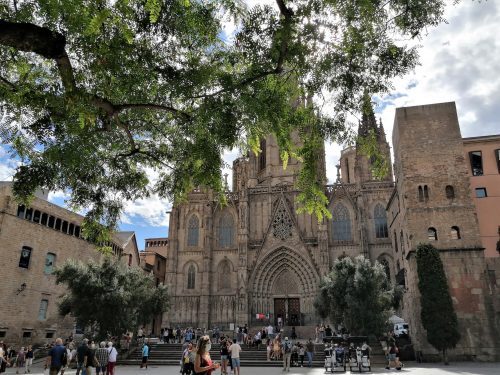 10 Places To Visit in Barcelona’s Gothic Quarter
10 Places To Visit in Barcelona’s Gothic Quarter
If you want to jump from one century into another with just a few steps, the Gothic Quarter in Barcelona is the place…
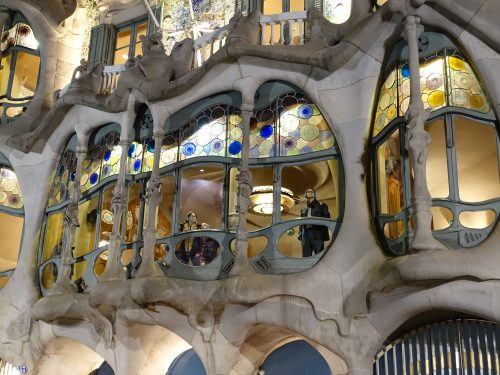 Where To See the Best Modernist Buildings in Barcelona
Where To See the Best Modernist Buildings in Barcelona
If you’re planning a visit to Barcelona, you’ve probably heard about its incredible modernist architecture. Catalan modernism, also called “modernisme,” is an architectural…